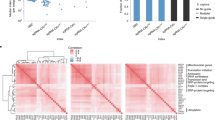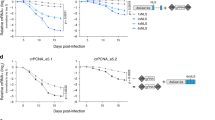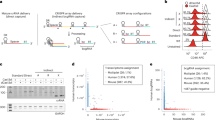Abstract
CRISPR–Cas9 screening allows genome-wide interrogation of gene function. Currently, to achieve the high and uniform Cas9 expression desirable for screening, one needs to engineer stable and clonal Cas9-expressing cells—an approach that is not applicable in human primary cells. Guide Swap permits genome-scale pooled CRISPR–Cas9 screening in human primary cells by exploiting the unexpected finding that editing by lentivirally delivered, targeted guide RNAs (gRNAs) occurs efficiently when Cas9 is introduced in complex with nontargeting gRNA. We validated Guide Swap in depletion and enrichment screens in CD4+ T cells. Next, we implemented Guide Swap in a model of ex vivo hematopoiesis, and identified known and previously unknown regulators of CD34+ hematopoietic stem and progenitor cell (HSPC) expansion. We anticipate that this platform will be broadly applicable to other challenging cell types, and thus will enable discovery in previously inaccessible but biologically relevant human primary cell systems.
This is a preview of subscription content, access via your institution
Access options
Access Nature and 54 other Nature Portfolio journals
Get Nature+, our best-value online-access subscription
$29.99 / 30 days
cancel any time
Subscribe to this journal
Receive 12 print issues and online access
$259.00 per year
only $21.58 per issue
Buy this article
- Purchase on Springer Link
- Instant access to full article PDF
Prices may be subject to local taxes which are calculated during checkout



Similar content being viewed by others
References
Arroyo, J. D. et al. A genome-wide CRISPR death screen identifies genes essential for oxidative phosphorylation. Cell. Metab. 24, 875–885 (2016).
Chen, S. et al. Genome-wide CRISPR screen in a mouse model of tumor growth and metastasis. Cell 160, 1246–1260 (2015).
DeJesus, R. et al. Functional CRISPR screening identifies the ufmylation pathway as a regulator of SQSTM1/p62. eLife 5, e17290 (2016).
Kurata, M. et al. Using genome-wide CRISPR library screening with library resistant DCK to find new sources of Ara-C drug resistance in AML. Sci. Rep. 6, 36199 (2016).
Ma, H. et al. A CRISPR-based screen identifies genes essential for West-Nile-virus-induced cell death. Cell Rep. 12, 673–683 (2015).
Park, R. J. et al. A genome-wide CRISPR screen identifies a restricted set of HIV host dependency factors. Nat. Genet. 49, 193–203 (2017).
Parnas, O. et al. A genome-wide CRISPR screen in primary immune cells to dissect regulatory networks. Cell 162, 675–686 (2015).
Ruiz, S. et al. A genome-wide CRISPR screen identifies CDC25A as a determinant of sensitivity to ATR inhibitors. Mol. Cell 62, 307–313 (2016).
Schmid-Burgk, J. L. et al. A genome-wide CRISPR (clustered regularly interspaced short palindromic repeats) screen identifies NEK7 as an essential component of NLRP3 inflammasome activation. J. Biol. Chem. 291, 103–109 (2016).
Shalem, O. et al. Genome-scale CRISPR-Cas9 knockout screening in human cells. Science 343, 84–87 (2014).
Sidik, S. M. et al. A genome-wide CRISPR screen in toxoplasma identifies essential apicomplexan genes. Cell 166, 1423–1435 (2016).
Song, C. Q. et al. Genome-wide CRISPR screen identifies regulators of mitogen-activated protein kinase as suppressors of liver tumors in mice. Gastroenterology 152, 1161–1173 (2017).
Tzelepis, K. et al. A CRISPR dropout screen identifies genetic vulnerabilities and therapeutic targets in acute myeloid leukemia. Cell Rep. 17, 1193–1205 (2016).
Virreira Winter, S., Zychlinsky, A. & Bardoel, B. W. Genome-wide CRISPR screen reveals novel host factors required for Staphylococcus aureus α-hemolysin-mediated toxicity. Sci. Rep. 6, 24242 (2016).
Zhang, R. et al. A CRISPR screen defines a signal peptide processing pathway required by flaviviruses. Nature 535, 164–168 (2016).
Wang, T., Wei, J. J., Sabatini, D. M. & Lander, E. S. Genetic screens in human cells using the CRISPR-Cas9 system. Science 343, 80–84 (2014).
Breschi, A., Gingeras, T. R. & Guigó, R. Comparative transcriptomics in human and mouse. Nat. Rev. Genet. 18, 425–440 (2017).
Gundry, M. C. et al. Highly efficient genome editing of murine and human hematopoietic progenitor cells by CRISPR/Cas9. Cell Rep. 17, 1453–1461 (2016).
Hendel, A. et al. Chemically modified guide RNAs enhance CRISPR-Cas genome editing in human primary cells. Nat. Biotechnol. 33, 985–989 (2015).
Schumann, K. et al. Generation of knock-in primary human T cells using Cas9 ribonucleoproteins. Proc. Natl. Acad. Sci. USA 112, 10437–10442 (2015).
Sykes, S. M. & Scadden, D. T. Modeling human hematopoietic stem cell biology in the mouse. Semin. Hematol. 50, 92–100 (2013).
Chen, D. S. & Davis, M. M. Cellular immunotherapy: antigen recognition is just the beginning. Springer Semin. Immunopathol. 27, 119–127 (2005).
Kumar, M., Keller, B., Makalou, N. & Sutton, R. E. Systematic determination of the packaging limit of lentiviral vectors. Hum. Gene Ther. 12, 1893–1905 (2001).
D’Astolfo, D. S. et al. Efficient intracellular delivery of native proteins. Cell 161, 674–690 (2015).
Wright, A. V. et al. Rational design of a split-Cas9 enzyme complex. Proc. Natl. Acad. Sci. USA 112, 2984–2989 (2015).
Hart, T. et al. High-resolution CRISPR screens reveal fitness genes and genotype-specific cancer liabilities. Cell 163, 1515–1526 (2015).
Majeti, R., Park, C. Y. & Weissman, I. L. Identification of a hierarchy of multipotent hematopoietic progenitors in human cord blood. Cell Stem Cell 1, 635–645 (2007).
Boitano, A. E. et al. Aryl hydrocarbon receptor antagonists promote the expansion of human hematopoietic stem cells. Science 329, 1345–1348 (2010).
Yao, H. et al. Corepressor Rcor1 is essential for murine erythropoiesis. Blood 123, 3175–3184 (2014).
Jaitin, D. A. et al. Dissecting immune circuits by linking CRISPR-pooled screens with single-cell RNA-seq. Cell 167, 1883–1896 (2016).
Dixit, A. et al. Perturb-Seq: dissecting molecular circuits with scalable single-cell RNA profiling of pooled genetic screens. Cell 167, 1853–1866 (2016).
Adamson, B. et al. A multiplexed single-cell CRISPR screening platform enables systematic dissection of the unfolded protein response. Cell 167, 1867–1882 (2016).
Doench, J. G. et al. Rational design of highly active sgRNAs for CRISPR-Cas9-mediated gene inactivation. Nat. Biotechnol. 32, 1262–1267 (2014).
König, R. et al. A probability-based approach for the analysis of large-scale RNAi screens. Nat. Methods 4, 847–849 (2007).
Li, W. et al. MAGeCK enables robust identification of essential genes from genome-scale CRISPR/Cas9 knockout screens. Genome Biol. 15, 554 (2014).
Tripathi, S. et al. Meta- and orthogonal integration of influenza “OMICs” data defines a role for UBR4 in virus budding. Cell Host Microbe 18, 723–735 (2015).
Brinkman, E. K., Chen, T., Amendola, M. & van Steensel, B. Easy quantitative assessment of genome editing by sequence trace decomposition. Nucleic Acids Res. 42, e168 (2014).
Wang, Q. et al. Tagmentation-based whole-genome bisulfite sequencing. Nat. Protoc. 8, 2022–2032 (2013).
Li, H. & Durbin, R. Fast and accurate short read alignment with Burrows-Wheeler transform. Bioinformatics 25, 1754–1760 (2009).
Lai, Z. et al. VarDict: a novel and versatile variant caller for next-generation sequencing in cancer research. Nucleic Acids Res. 44, e108 (2016).
Sherry, S. T. et al. dbSNP: the NCBI database of genetic variation. Nucleic Acids Res. 29, 308–311 (2001).
Acknowledgements
We thank G. Hoffman (Novartis Institutes for Biomedical Research, Cambridge, MA, USA) for the genome-wide gRNA library; J. Zhang and A. Romero for gRNA library preparation; B. Tschantz (Novartis Institutes for Biomedical Research, Cambridge, MA, USA) for sharing the Cas9 expression plasmid; A. Angel, M. Andahazy, S. Fiola, S. Cellitti, B. Lam, J. Rogers, G. Spraggon, M. Ratnikov, T. Orth, D. Jones and G. Joyce for helpful discussions; and Y. Yang for critical reading of the manuscript.
Author information
Authors and Affiliations
Contributions
P.Y.T., J.L.S., A.E.P., A.E.B. and M.P.C. conceived the study. P.Y.T. conceived the Guide Swap strategy. P.Y.T. and J.L.S. analyzed the data and wrote the manuscript, with input from all other authors. P.Y.T., A.E.P., J.S.L, C.S. and J.L.S. designed the experiments. P.Y.T. performed the HSPC experiments. A.E.P. performed the T cell experiments. J.S.L. performed the in vitro cleavage assays, CT26 knockout and RSA analysis. J.V., M.-Y.G. and H.E.K. produced the Cas9 protein. L.J.M. provided the gRNA libraries. C.T. and O.S. carried out fluorescence-activated cell sorting. F.L., G.F., S.W.B. and J.R.W. obtained and analyzed next-generation sequencing data for the screens. J.L. analyzed the HSPC pooled screening data. S.C. and C.R. performed and analyzed next-generation sequencing for quantification of indels. J.L.S., C.S., J.L. and P.M. oversaw the research.
Corresponding author
Ethics declarations
Competing interests
P.Y.T., A.E.P., J.S.L., C.T., O.S., F.L., G.F., S.W.B., J.R.W., H.E.K., J.V., M.-Y.G., S.C., C.R., L.J.M., M.P.C., A.E.B., P.M., J.L., C.S. and J.L.S. were employees of Novartis when the research was conducted. P.Y.T., J.L.S., J.S.L. and C.S. are named as inventors on US provisional patent application no. 62/591,648 filed by the Genomics Institute of the Novartis Research Foundation.
Additional information
Publisher’s note: Springer Nature remains neutral with regard to jurisdictional claims in published maps and institutional affiliations.
Integrated supplementary information
Supplementary Figure 1 Efficient gene disruption and protein knockout by RNP-mediated delivery of Cas9 to lenti-gRNA-transduced cells.
(a) Schematic of experiment comparing editing at lenti gRNA-directed target location using different methods of Cas9 delivery. (b) Representative plots of FACS gating strategy. Live cells were gated by DAPI exclusion. Doublets were discriminated using FSC-W vs. FSC-H, followed by SSC-W vs. SSC-H. Representative RFP gating is shown. (c) NGS analysis of CD45 editing efficiency in HSPC 5 days post-electroporation; n = two technical replicates and two sequencing replicates. The samples are from the same experiment as in Fig. 1a. (d) Representative histogram of CD33 expression (top) and CD45 expression (bottom) 4 days after nt_A RNP-electroporation of HSPC transduced with the indicated lenti gRNA. Gated on RFP + cells. The experiment was repeated in three independent donors with similar results. (e) Representative FACS plots of CD45 expression in human primary CD3 + T cells 4 days post-electroporation. The experiment was performed with two technical replicates and repeated once with independent gRNAs with similar results. (f) Western blot analysis of MTAP knockout in CT26; representative of four independent experiments.
Supplementary Figure 2 RNP-mediated Cas9 outperforms Cas9 alone in enabling efficient editing with lenti gRNA in CD34+ HSPCs and CD4+ T cells.
(a) Flow cytometry analysis of CD45 knockout efficiency 4 days post-electroporation. Transduced CD34 + HSPC were electroporated with indicated amounts of Cas9, or non-targeting RNP (6 µg Cas9 pre-complexed with 6 µg non-targeting synthetic split gRNA). Lenti gRNA-expressing cells were gated using RFP. The four lenti gRNAs were assayed and analyzed separately in four independent experiments, but have been graphed on the same Y-axis for readability. The 6 µg Cas9 and RNP data points are the same as those in Fig. 1a. n = 2 technical replicates. (b) Flow cytometry analysis of CD45 (left) and CXCR4 (right) knockout. Experiment was similar to (a) except performed in T cells. The 6 µg Cas9 and RNP data points are the same as those in Fig. 1b. n = 2 technical replicates.
Supplementary Figure 3 Efficient CD45 knockout using lenti gRNA and RNPs of varied gRNA targets and formats.
(a)-(c) are representative of multiple lenti gRNAs tested in two independent experiments with similar results. (a) Flow cytometry analysis of CD45 knockout efficiency 4 days post-electroporation of transduced CD34 + HSPC with indicated RNPs. Lentiviral gRNA-expressing cells were gated using RFP. n = 2 technical replicates. The SRPK1 and ZNRF3 gRNAs were unmodified. All other gRNAs were chemically modified. (b) Flow cytometry analysis of CD45 knockout efficiency 4 days post-electroporation of transduced CD34 + HSPC with indicated RNPs (dg = synthetic split gRNA; sg = synthetic single gRNA). Lenti gRNA-expressing cells were gated using the RFP marker. n = 2 technical replicates. (c) Representative FACS plots of CD33 and CD45 expression 4 days post-electroporation with indicated RNPs. Lenti gRNA-expressing cells were gated using the RFP marker.
Supplementary Figure 4 gRNA binding enhances Cas9 delivery by electroporation.
(a) Representative histograms of Cas9 FACS staining. protK = proteinase K. perm = permeabilization. Representative of two independent experiments with similar results. (b-c) CD34 + HSPC were transduced with lenti gRNA CD45_B, then electroporated with 6 µg of Cas9 and 6 µg of RNA as indicated. cr = crRNA. tr = tracrRNA. scram = scrambled sequence RNA. sg = single synthetic guide. The experiment was repeated once with similar results. (b) Fold change in MFI (median fluorescence intensity) of intracellular Cas9 FACS staining, compared to appropriate non-permeabilized control for each condition. n = 3 technical replicates, data are presented as mean. (c) Flow cytometry analysis of CD45 knockout efficiency 4 days post-electroporation. Lenti gRNA-expressing cells were gated using RFP. n = 3 technical replicates, data are presented as mean. (d, e) Agarose gel electrophoresis analysis of indicated dsDNA templates cleaved by indicated Cas9-gRNA RNP complexes. Mtap = Mtap_A. * = uncleaved DNA template. <= excess undigested RNA. dg = split gRNA. IVT = in vitro transcribed gRNA; representative of two independent experiments.
Supplementary Figure 5 Guide Swap is amenable to genome-scale screening.
(a) CD34 + HSPC were transduced with the indicated lenti gRNAs, then electroporated with indicated amounts of RNP where X µg RNP = X µg Cas9 + X µg nt_A gRNA (1:1 crRNA:tracrRNA). CD45 expression was assessed by flow cytometry. Lenti gRNA-expressing cells were gated using RFP. n = 2 technical replicates. (b) Same as above except in T cells. CD45 (left) and CXCR4 (right) expression were assessed by flow cytometry. (c) The indicated numbers of transduced HSPC were pelleted and resuspended in 20 µL for electroporation. CD45 knockout was assessed by flow cytometry 4 days post-electroporation. Representative of multiple gRNAs tested in two independent experiments with similar results.
Supplementary Figure 6 Pooled Guide Swap screens in human primary CD4+ T cells.
(a) Cumulative distribution of the Log2 normalized reads per million per gRNA at Day 0 (magenta) and Day 6 RFP + CD4 + CD45 + CXCR4 + (blue) for one replicate. (b-c) Comparison of normalized reads per million in (b) Day 0 replicates and (c) Day 6 RFP + CD4 + CD45 + CXCR4 + replicates. r = Pearson correlation coefficient calculated from two technical replicates. (d) Day 6 RFP + CD4- versus Day 0 comparison of log2 fold changes in replicates for gRNAs that regulate CD4 surface expression. CD4 spike-in gRNAs are colored in blue. CD4 gRNAs present in the library are colored in magenta. (e) Day 6 RFP + CD45- versus Day 0 comparison of log2 fold changes in replicates for gRNAs that regulate CD45 surface expression. CD45 spike-in gRNAs are colored in blue. CD45 gRNAs present in the library are colored in magenta. Two gRNAs that were spiked in were also present in the library, and these are colored in purple. (f) Venn diagram of gene hits from RSA and 2nd best gRNA analyses of Day 6 RFP + CD4 + CD45 + CXCR4 + versus Day 0 samples.
Supplementary Figure 7 Guide Swap is amenable to genome-scale screening in CD34+ HSPCs.
(a) CD33 (left) and CD45 (right) knockout efficiency in CD34 + HSPC from indicated donors. Gated on RFP + cells; two technical replicates in one experiment. mPB = mobilized peripheral blood. CB = cord blood. (b) Representative FACS plots of CD45 knockout in cord blood CD34 + CD90 + cells (top). Gating strategy for CD34 + CD90- and CD34 + CD90 + populations (bottom left). CD45 knockout efficiency in CB CD34 + CD90- and CD34 + CD90 + cells (bottom right). n = 2 technical replicates; representative of multiple gRNAs tested in two independent experiments with similar results. (c) CD34 + HSPC recovery 20 h post-electroporation, normalized to starting cell number. n = 8 technical replicates, data is presented as the mean. (d) Representative FACS plots of CD45RA and CD34 expression 7 and 14 days post-electroporation; two technical replicates in one experiment.
Supplementary Figure 8 Additional validated hits from the HSPC screen.
(a) Cumulative distribution of the Log2 normalized reads per million per gRNA in the CD34- (blue) and CD34 + (magenta) populations. (b) Representative FACS plots of CD45RA and CD34 expression 10 days post-electroporation with indicated RNPs; two technical replicates in one experiment. (c) Representative FACS plots of fluorescence in the APC channel and CD34 expression 10 days post-electroporation with indicated RNPs; two technical replicates in one experiment.
Supplementary Figure 9 Surface phenotype of selected HSPC hits.
FACS plots of CD90, CD34, CD45RA, CD41a and CD71 expression 10 and 20 days post-electroporation with indicated RNPs; representative of two technical replicates; two independent experiments.
Supplementary information
Supplementary Text and Figures
Supplementary Figures 1–9 and Supplementary Tables 1–3
Supplementary Data 1
RPM, RSA analysis and second-best ranking analysis of T cell depletion and enrichment screens
Supplementary Data 2
RPM and second-best ranking analysis of HSPC enrichment screen
Source data
Rights and permissions
About this article
Cite this article
Ting, P.Y., Parker, A.E., Lee, J.S. et al. Guide Swap enables genome-scale pooled CRISPR–Cas9 screening in human primary cells. Nat Methods 15, 941–946 (2018). https://doi.org/10.1038/s41592-018-0149-1
Received:
Accepted:
Published:
Issue Date:
DOI: https://doi.org/10.1038/s41592-018-0149-1
This article is cited by
-
Functional CRISPR screens in T cells reveal new opportunities for cancer immunotherapies
Molecular Cancer (2024)
-
Combining different CRISPR nucleases for simultaneous knock-in and base editing prevents translocations in multiplex-edited CAR T cells
Genome Biology (2023)
-
Massively parallel knock-in engineering of human T cells
Nature Biotechnology (2023)
-
Sniper2L is a high-fidelity Cas9 variant with high activity
Nature Chemical Biology (2023)
-
Deletion of SNX9 alleviates CD8 T cell exhaustion for effective cellular cancer immunotherapy
Nature Communications (2023)



